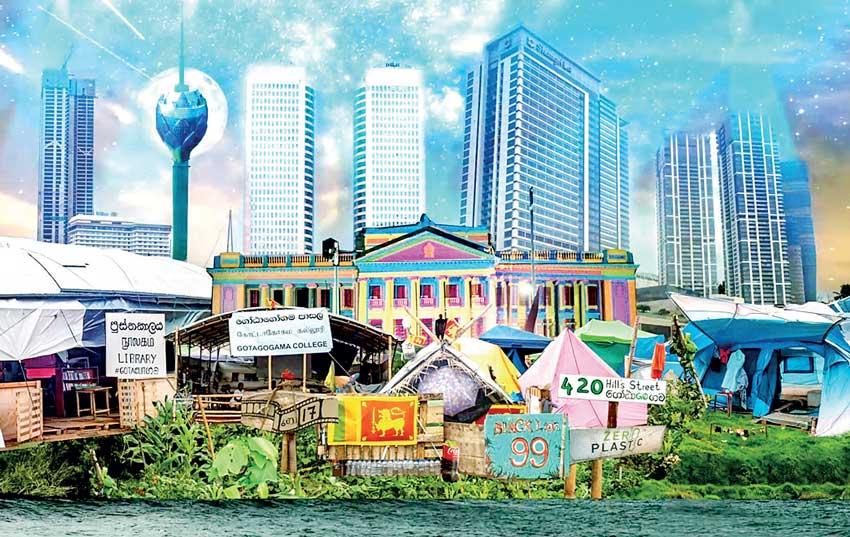01 Oct 2022 - {{hitsCtrl.values.hits}}

 If your house was burning down, what would you try to take with you as you ran out? For many of us, and I am dating myself here, the answer would be our childhood albums, which capture our most cherished memories. For the children of today, where are all those priceless memories stored? On a cloud somewhere over the rainbow - for all we know.
If your house was burning down, what would you try to take with you as you ran out? For many of us, and I am dating myself here, the answer would be our childhood albums, which capture our most cherished memories. For the children of today, where are all those priceless memories stored? On a cloud somewhere over the rainbow - for all we know.
In the same vein, the next generation will appreciate art that they can carry with them, but virtually. Studies have shown that today’s youth are either priced out of the astronomical housing market, or they prefer to rent / Airbnb. They don’t dream of a owning a house in the same way that the boomers and gen-x did. Like seemingly everything else in their millennial, gen-z and now, “gen-alpha” lives, they want art at their fingertips.
Of course, there will always be a distinctive market for physical art to display in homes, offices and public spaces. After all, the comparison between traditional and digital art will never be comparing apples to apples. Broadway can never be replaced by Netflix. Similarly, the future of art will likely be a hybrid, comprised of both these two art forms. In this mix, NFTs will play an important role; they could be used as material representations of purchased NFTs and/or the new certificates of authenticity.
What is an NFT anyway? An NFT, AKA “non-fungible token” is a unique record on a blockchain, affiliated with a particular asset (art, real estate, etc.). The phone you are holding could be an NFT - take a picture of it and apply a unique digital identifier on the blockchain to it. Tada, NFT!
It just would not hold a lot of value in an online marketplace, and that’s where NFTS can be easily traded and sold, just like other cybercurrencies. This protects owners against damage, deterioration and theft, also allowing for greater transparency and clearer provenance; a game-changing aspect for the art world. Additionally, as incontrovertible certificates validating ownership, they are also easier to pass down from generation to generation.
The tokens also empower artists to take control of their art, as well as their payment terms, especially those not represented by a gallery. Smart contracts can enable royalties to be paid based on conditions and parameters, written in code, that trigger compensation when met.
I recently attended a conference in Geneva and took a deep-dive into Web3. Although we most often hear of NFTs in the context of art, the real impact of NFTs will be unleashed as the metaverse infiltrates more and more aspects of human-life. NFTs will likely serve as the proof of ownership of anything in the metaverse – real estate, collectibles, designer apparel, etc.
Designer apparel in the metaverse seems like a far-flung concept and a distant concern considering Sri Lanka’s current issues. However, in actuality, although in a different format, art, including digital, was such a vital and critical component of the struggle at GotaGoGama. An example that will be entrenched in my memory are the digital projections onto the Presidential Secretariat using 3D mapping.
It is in a similar spirit that THE BRILLIANT RESILIENT: SRI LANKA’S FIRST CURATED NFT DIGITAL ART EXHIBITION was launched. The pioneering digital platform, The Upside Space (TUS), will offer the creators, and thereby the movement, international exposure. TUS was co-founded by actor, writer and entrepreneur Lisa Ray and her partner, art professional and philanthropist, Ayesha Khan. Lisa is currently on the island for the physical outpost of the NFT exhibit. The hybrid launch took place at Canada House where she mentioned her deep connection with Sri Lanka, created after filming the Oscar-nominated Deepa Mehta film, Water, in Colombo. She also stressed her commitment to featuring creators from all over South Asia and the Middle East.
|
9/5/22 by Anoma |
The exhibit, curated by Kesara Ratnavibhushana, had the works of 15 Sri Lankan artists on display. Each artist’s creative response to the socio-economic challenges that Sri Lanka is undergoing, represented in different styles and techniques, are connected through a comprehensive theme of a powerful rally for change. These pieces were meticulously selected for their portrayal of citizen activism, embodying hope for the country.
Renowned and prolific artists including Anoma, Anoli Perera and Prageeth Manohansa will be offering limited edition prints as well as physical pieces to the first collectors of their NFTs. Also featured are Nuwan Shilpa, Aamina Nizar, Devika Brandon and Vasi Samudra Devi. The entire collection includes 26 NFT artworks and 7 physical pieces.
TUS also plans to educate the market; NFTs, after all, are a new and complex notion. Here’s one question to start: what happens when someone owns a physical piece of art and someone else owns the NFT of it?
Due to complications such as these, some of the world’s esteemed galleries, including the Saskia Fernando Gallery in Sri Lanka, are taking a wait and watch approach to NFTs. There is some unease about their speculative nature, and about the need for stringent regulation necessary to avert potential fraud, protect data privacy and ensure transaction security. As governments and other large institutions work towards developing more secure blockchain technology, the adaptation is expected to grow exponentially. Speaking of ownership, The Merge, a celebrated digital artwork, was sold on an NFT marketplace for $91.8 million, but as digital fragmented art, with ownership shared by 98,983 collectors.
Esteemed auction houses such as Christie’s and Sotheby’s have jumped on the NFT bandwagon selling collections of images for astronomical sums, but also at an environmental cost. The maintenance of the cryptocurrency technology used to pay for many NFTs produces carbon-dioxide and greenhouse emissions that are environmentally harmful, and on that front, there has been a major backlash against NFTs. Many artists are now moving towards “energy-efficient NFTs” by mandating carbon neutrality through a matching investment in renewable energy. As people become more and more eco-conscious, the sustainability of these NFTs is critical for their endurance.
Even Starbucks has launched their own NFT-loyalty program on an environmentally sustainable platform – a frappuccino with a side of an NFT? It will be interesting to see how NFTs manifest into our day-to-day lives as well as how they interplay with physical art, both of which, it seems, will be co-existing in the years to come.
15 Nov 2024 33 minute ago
15 Nov 2024 2 hours ago
15 Nov 2024 3 hours ago
15 Nov 2024 3 hours ago
15 Nov 2024 3 hours ago